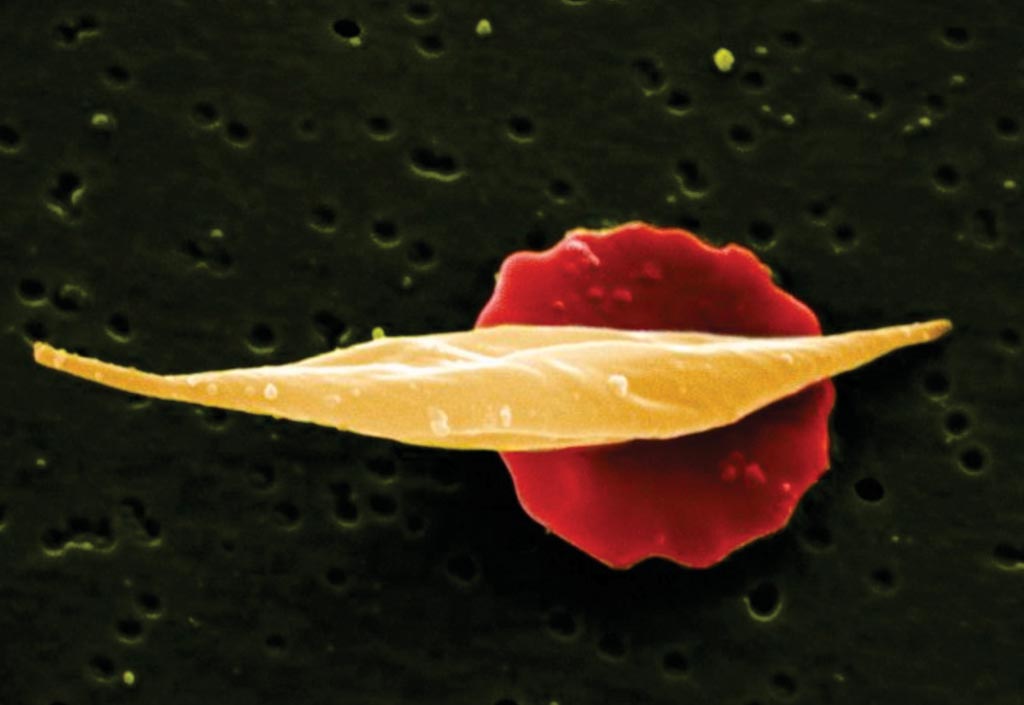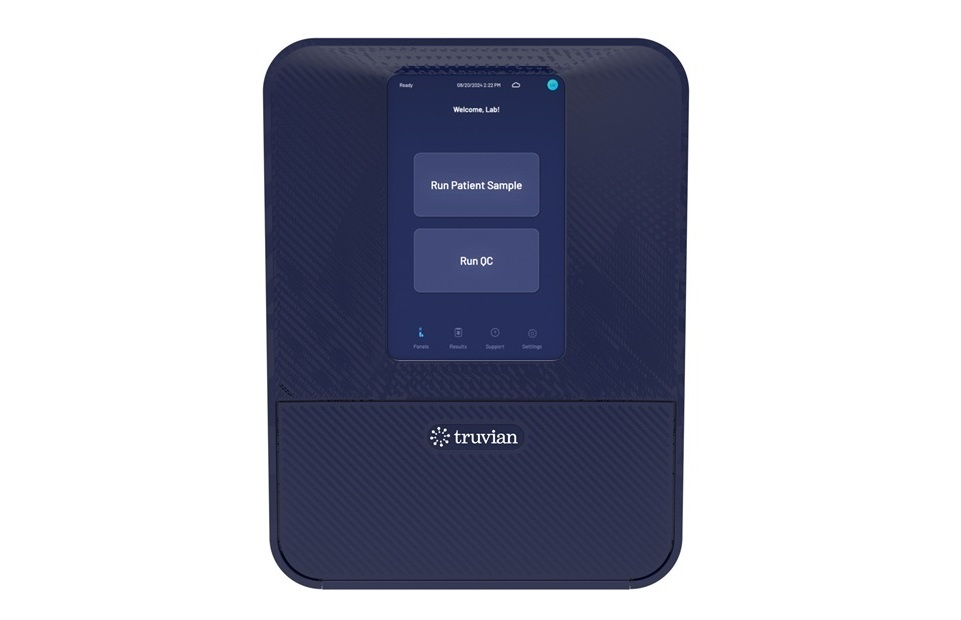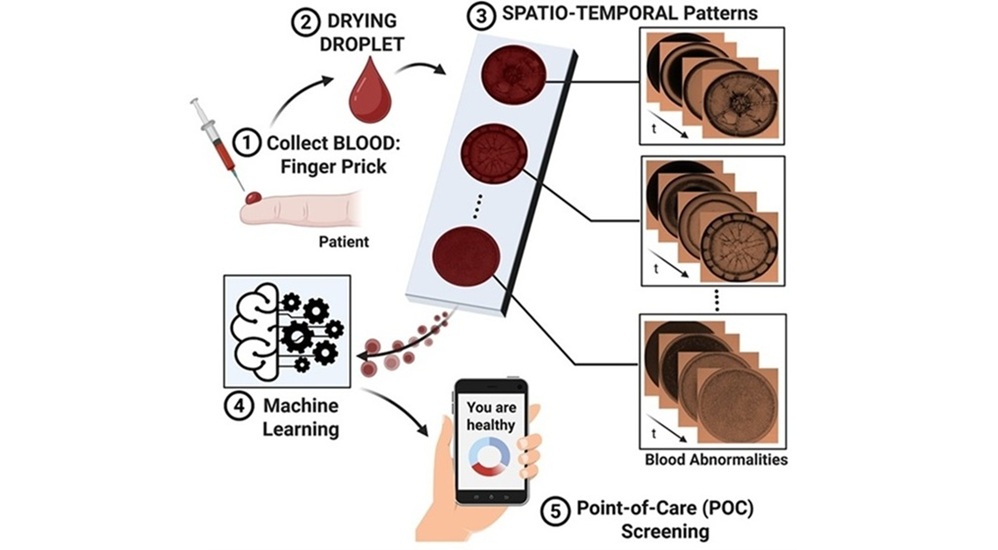Infections Identified in Pediatric Sickle Cell Disease
|
By LabMedica International staff writers Posted on 21 Mar 2019 |

Image: A scanning electron micrograph (SEM) showing long sickle cell in front of more disc-shaped normal red cell (Photo courtesy of the Wellcome Trust).
Sickle cell anemia is a hereditary disorder of autosomal recessive inheritance that is characterized by sickle-shaped red blood cells. It is the most common type of hemoglobinopathy and is the result of a mutation in the β-globin chain gene that results in creating sickle hemoglobin (HbS) instead of the normal adult hemoglobin (HbA).
Children with sickle cell disease (SCD) are at increased risk for invasive infection with encapsulated bacteria. Antibiotic prophylaxis and immunizations against Streptococcus pneumoniae and Haemophilus influenzae type b (Hib) have decreased the overall incidence of invasive infections and have shifted distribution of serotypes causing disease toward those not covered by immunizations.
Scientists at Emory University (Atlanta, GA, USA) and their colleagues reviewed a large pediatric tertiary care center to identify all isolates of H. influenzae detected in sterile body fluid cultures from January 1, 2010, to December 31, 2017. The results were compared with the center's comprehensive clinical database of all children with SCD to identify all cases of children ages 0 to18 years with SCD with invasive H. influenzae disease for the same time period.
The team found 2,444 patients with SCD, with 14,336 person-years. There were eight episodes of H. influenzae bacteremia in seven children with SCD (five type f, two non-typable, one type a). Most episodes (7/8) were in children younger than five years. The incidence rate of invasive H. influenzae in SCD was 0.58/1,000 person-years for ages 0 to 18 years and 1.60/1,000 person-years for children age less than five years. There were no deaths from H. influenzae infection.
The authors concluded that in the era of universal antibiotic prophylaxis and immunization against Hib, invasive H. influenzae disease due to non-vaccine serotypes remains a risk for children with SCD, particularly those under five years of age. The study was published on February 5, 2019, in the journal Pediatric Blood & Cancer.
Related Links:
Emory University
Children with sickle cell disease (SCD) are at increased risk for invasive infection with encapsulated bacteria. Antibiotic prophylaxis and immunizations against Streptococcus pneumoniae and Haemophilus influenzae type b (Hib) have decreased the overall incidence of invasive infections and have shifted distribution of serotypes causing disease toward those not covered by immunizations.
Scientists at Emory University (Atlanta, GA, USA) and their colleagues reviewed a large pediatric tertiary care center to identify all isolates of H. influenzae detected in sterile body fluid cultures from January 1, 2010, to December 31, 2017. The results were compared with the center's comprehensive clinical database of all children with SCD to identify all cases of children ages 0 to18 years with SCD with invasive H. influenzae disease for the same time period.
The team found 2,444 patients with SCD, with 14,336 person-years. There were eight episodes of H. influenzae bacteremia in seven children with SCD (five type f, two non-typable, one type a). Most episodes (7/8) were in children younger than five years. The incidence rate of invasive H. influenzae in SCD was 0.58/1,000 person-years for ages 0 to 18 years and 1.60/1,000 person-years for children age less than five years. There were no deaths from H. influenzae infection.
The authors concluded that in the era of universal antibiotic prophylaxis and immunization against Hib, invasive H. influenzae disease due to non-vaccine serotypes remains a risk for children with SCD, particularly those under five years of age. The study was published on February 5, 2019, in the journal Pediatric Blood & Cancer.
Related Links:
Emory University
Latest Hematology News
- Platelet Activity Blood Test in Middle Age Could Identify Early Alzheimer’s Risk
- Microvesicles Measurement Could Detect Vascular Injury in Sickle Cell Disease Patients
- ADLM’s New Coagulation Testing Guidance to Improve Care for Patients on Blood Thinners
- Viscoelastic Testing Could Improve Treatment of Maternal Hemorrhage
- Pioneering Model Measures Radiation Exposure in Blood for Precise Cancer Treatments
- Platelets Could Improve Early and Minimally Invasive Detection of Cancer
- Portable and Disposable Device Obtains Platelet-Rich Plasma Without Complex Equipment
- Disposable Cartridge-Based Test Delivers Rapid and Accurate CBC Results
- First Point-of-Care Heparin Monitoring Test Provides Results in Under 15 Minutes

- New Scoring System Predicts Risk of Developing Cancer from Common Blood Disorder
- Non-Invasive Prenatal Test for Fetal RhD Status Demonstrates 100% Accuracy
- WBC Count Could Predict Severity of COVID-19 Symptoms
- New Platelet Counting Technology to Help Labs Prevent Diagnosis Errors
- Streamlined Approach to Testing for Heparin-Induced Thrombocytopenia Improves Diagnostic Accuracy
- POC Hemostasis System Could Help Prevent Maternal Deaths
- New Test Assesses Oxygen Delivering Ability of Red Blood Cells by Measuring Their Shape
Channels
Clinical Chemistry
view channel
Chemical Imaging Probe Could Track and Treat Prostate Cancer
Prostate cancer remains a leading cause of illness and death among men, with many patients eventually developing resistance to standard hormone-blocking therapies. These drugs often lose effectiveness... Read more
Mismatch Between Two Common Kidney Function Tests Indicates Serious Health Problems
Creatinine has long been the standard for measuring kidney filtration, while cystatin C — a protein produced by all human cells — has been recommended as a complementary marker because it is influenced... Read moreMolecular Diagnostics
view channel
Portable Molecular Test Detects STIs at POC in 15 Minutes
Sexually transmitted infections (STIs) such as Chlamydia trachomatis and Neisseria gonorrhoeae affect more than 370 million people annually, with women in low- and middle-income countries facing the greatest... Read more
Benchtop Analyzer Runs Chemistries, Immunoassays and Hematology in Single Device
Routine blood tests remain dependent on off-site laboratories, resulting in delays, higher costs, and logistical barriers in decentralized care settings. Now, a new multimodal diagnostic solution delivers... Read moreHematology
view channel
Platelet Activity Blood Test in Middle Age Could Identify Early Alzheimer’s Risk
Early detection of Alzheimer’s disease remains one of the biggest unmet needs in neurology, particularly because the biological changes underlying the disorder begin decades before memory symptoms appear.... Read more
Microvesicles Measurement Could Detect Vascular Injury in Sickle Cell Disease Patients
Assessing disease severity in sickle cell disease (SCD) remains challenging, especially when trying to predict hemolysis, vascular injury, and risk of complications such as vaso-occlusive crises.... Read more
ADLM’s New Coagulation Testing Guidance to Improve Care for Patients on Blood Thinners
Direct oral anticoagulants (DOACs) are one of the most common types of blood thinners. Patients take them to prevent a host of complications that could arise from blood clotting, including stroke, deep... Read moreImmunology
view channel
Gene Signature Test Predicts Response to Key Breast Cancer Treatment
DK4/6 inhibitors paired with hormone therapy have become a cornerstone treatment for advanced HR+/HER2– breast cancer, slowing tumor growth by blocking key proteins that drive cell division.... Read more
Chip Captures Cancer Cells from Blood to Help Select Right Breast Cancer Treatment
Ductal carcinoma in situ (DCIS) accounts for about a quarter of all breast cancer cases and generally carries a good prognosis. This non-invasive form of the disease may or may not become life-threatening.... Read morePathology
view channel
Diagnostic Technology Performs Rapid Biofluid Analysis Using Single Droplet
Diagnosing disease typically requires milliliters of blood drawn at clinics, depending on needles, laboratory infrastructure, and trained personnel. This process is often painful, resource-intensive, and... Read more
Novel Technology Tracks Hidden Cancer Cells Faster
Targeting and treating disease often hinges on the ability to locate specific cells inside the body—a challenge made difficult because harmful or therapeutic cells move through tissues and are not easily detected.... Read moreTechnology
view channel
AI Saliva Sensor Enables Early Detection of Head and Neck Cancer
Early detection of head and neck cancer remains difficult because the disease produces few or no symptoms in its earliest stages, and lesions often lie deep within the head or neck, where biopsy or endoscopy... Read more
AI-Powered Biosensor Technology to Enable Breath Test for Lung Cancer Detection
Detecting lung cancer early remains one of the biggest challenges in oncology, largely because current tools are invasive, expensive, or unable to identify the disease in its earliest phases.... Read moreIndustry
view channel
Abbott Acquires Cancer-Screening Company Exact Sciences
Abbott (Abbott Park, IL, USA) has entered into a definitive agreement to acquire Exact Sciences (Madison, WI, USA), enabling it to enter and lead in fast-growing cancer diagnostics segments.... Read more




 assay.jpg)



















